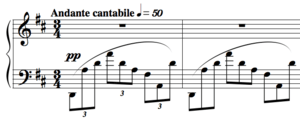Prelude in D major (Rachmaninoff)

The Prelude in D major, Op. 23 No. 4 is a 1903 composition by Sergei Rachmaninoff.[1][2] It is part of Rachmaninoff's Ten Preludes, Op. 23.
Structure
The prelude is in three variation form. The theme is introduced in two parts, the first in measure 3, and the second at measure 11:

Measure 3

Measure 11
The first variation on the theme occurs at measures 19-34. A triplet descant in the treble voice is added to the main theme, which is present in the right-hand alto voice. The right-hand voices are offset against an eighth-note figure in the left-land.

Measure 19
Variation two begins at measure 35. In contrast to the more subtle variation of the first variation, the second variation presents rhythmic changes. Triplets appear in the accompaniment, and shorter phrasing is utilized.

Measures 35 and 36
The piece then reaches its climax within the brief "B" section (measures 35-52) at measures 50-51.

Measures 50 and 51
The third variation marks a denouement, returning to the rhythm of the main theme. The triplet flow returns to the left-hand bass line, while a high counterpoint is introduced in the main melody.

Measures 53 and 54
Harmonically, the prelude is composed of traditional progressions. The theme and each variation begins in the tonic and moves briefly to a related key. For example, the quick movements to G major at measure 7, F-sharp minor at measure 11, and B minor at measure 29 illustrate these quick modulations.

Measures 6 and 7

Measures 28 and 29
References
External links
Detailed 5-layer analysis (by Lance Bastian)